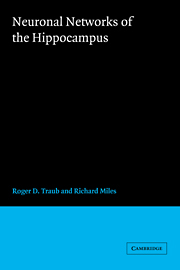Book contents
- Frontmatter
- Contents
- Acknowledgments
- Prologue
- 1 The hippocampus in context
- 2 Physiology of single neurons: voltage- and ligand-gated ionic channels
- 3 Synaptic function and organization of the CA3 region
- 4 The single-cell model
- 5 Model of the CA3 network
- 6 Collective behaviors of the CA3 network: experiment and model
- 7 Collective behaviors of the CA3 network: spontaneous oscillations and synchronized synaptic potentials
- 8 Field effects
- 9 Theoretical approaches: mathematical neural networks
- Conclusion
- Notes
- References
- Index
1 - The hippocampus in context
Published online by Cambridge University Press: 05 February 2012
- Frontmatter
- Contents
- Acknowledgments
- Prologue
- 1 The hippocampus in context
- 2 Physiology of single neurons: voltage- and ligand-gated ionic channels
- 3 Synaptic function and organization of the CA3 region
- 4 The single-cell model
- 5 Model of the CA3 network
- 6 Collective behaviors of the CA3 network: experiment and model
- 7 Collective behaviors of the CA3 network: spontaneous oscillations and synchronized synaptic potentials
- 8 Field effects
- 9 Theoretical approaches: mathematical neural networks
- Conclusion
- Notes
- References
- Index
Summary
Review of anatomy
In this chapter we shall review some aspects of the anatomy and physiology of the hippocampus, considering the hippocampus as only one component of the whole brain. We shall discuss also some clinical consequences of abnormal hippocampal function (epilepsy, amnestic states). Our purpose is to provide a biological background for the more detailed physiological and mathematical material to follow. We wish to define some of the relevant questions that can be answered in brain slices and in computer models of brain slices. We shall move freely between observations of the hippocampus from many different species (rodents, nonhuman primates, humans, and so on), assuming that the same general principles apply to all of them.
The hippocampus is a cortical structure that is necessary for the formation of new memories. The detailed mechanisms by which this function is accomplished are not well understood. The hippocampus in rodents contains cells that respond to spatial location (“place cells”). It generates characteristic EEG rhythms that depend on the behavioral state of animal. The hippocampus readily produces seizures in experimental contexts, and epileptic seizures originating in or near the hippocampus pose an important clinical problem.
The hippocampus forms a rather large part of the rodent brain (Paxinos and Watson, 1986). There is one hippocampus on each side of the brain. In humans, there is a hippocampus in each of the two medial temporal lobes.
Information
- Type
- Chapter
- Information
- Neuronal Networks of the Hippocampus , pp. 1 - 33Publisher: Cambridge University PressPrint publication year: 1991
Accessibility standard: Unknown
- 1
- Cited by
